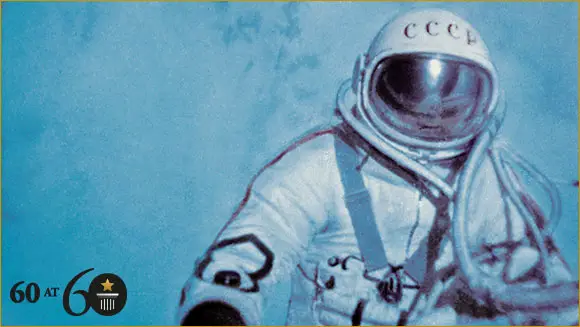
Born in 1934 in the tiny village of Listvyanka in Central Siberia, Alexei Leonov stands as the first person to take steps in outer space and take a view of our planet few will ever get to see from 500km above the earth.
While reports at the time of Leonov’s incredible endeavour painted the mission as a resounding success, we now know his dramatic, movie-like return to earth nearly ended in disaster.
Graduating as a fighter pilot by his early twenties, he was invited by the Russian space programme to compete for the opportunity to go into space, and would go on to join USSR’s original roster of 20 cosmonauts alongside Yuri Gagarin.
After receiving a summons in early 1963 to OKB-1, the main centre in Moscow for the construction of the USSR’s spaceships, the cosmonauts were shown a new batch of spacecrafts that looked vaguely similar to the vessel that Gagarin had made history in. However one of them was markedly different, sporting a 3m long transparent tube and an airlock.
As Sergei Korolev, the mastermind behind the USSR’s space program, showed them around the spacecraft, he turned to Leonov and told him: “You, little eagle, put on that suit.” His chance had come – Leonov was to head up a mission named Voskhod (Sunrise) 2, which required a spacewalker (also the navigator) and a commander to pilot the ship.
He would be joined by his good friend Pavel Belyayev on the mission who would be sitting in the commander’s seat.
Following almost two years of training and preparations, on the morning of 18 March 1965, the cosmonauts were woken up for their history-making flight.
Following a textbook launch, Voskhod 2 soon reached orbit. After Belyayev had deployed the airlock, Leonov strapped on his life support system, and, with an encouraging slap on the back from his comrade, Leonov crawled into the airlock and closed the hatch behind him. Eventually, the all-clear was given to open the external hatch and the brave cosmonaut left the vessel, making his way out into the unknown.
Looking down on the Earth below him, Leonov noticed night was turning to day, and Africa filled his field of view.
Attached by an “umbilical cord” that ensured he wouldn’t drift out into space, after plucking up the courage, he launched himself off the side of the spacecraft.
At first it seemed like a huge error of judgment as he went into a dangerous spin, but the cord soon pulled him to a stop.
After 12 minutes floating out in space, soaking up a view no other man had seen before, Leonov reluctantly prepared to return back to his spacecraft.
His epic adventure was only just beginning however.
Much to his dismay, the lack of atmospheric pressure in space had caused his spacesuit to massively inflate, making it impossible for him to fit inside the airlock.
At the risk of starving his body of oxygen, quick thinking Leonov decided to bleed half of the air out of his spacesuit through a valve in its lining without telling mission control.
He soon began to suffer the first stabs of decompression sickness, with pins and needles in his hands and legs indicating that he had just minutes to get inside the airlock.
Hauling himself into the spacecraft headfirst rather than the recommended feet first, the sheer exertion of the maneuver caused the temperature in his space suit to soar. As well as the very real issue of heatstroke, the perspiration on his visor had now temporarily blinded him.
Leonov somehow managed to safely make his way inside the cockpit, before the cosmonauts fired a small explosive charge to eject the airlock into space. This however caused the spacecraft to rotate wildly and go off course.
To compound the tension, oxygen levels within the ship were climbing at a dangerous rate making the inside of the cockpit dangerously flammable.
After some frantic work to lower the temperature and humidity onboard, the craft stabilised. Had the engines produced sparks during this time the spacecraft would have been all but vaporised.
Several hours later the pair prepared to return to earth, however their bad luck continued, when it became apparent that the spacecraft’s automatic re-entry system had malfunctioned.
This meant the men would have to fire the spacecraft’s retro-rockets manually – a feat that would require absolute precision - if the burn was too short, the Voskhod 2 would hit the atmosphere at too shallow an angle, causing it to bounce back into space.
The rocket firing luckily went to plan, however the cosmonauts now had little control over where they would land back on earth.
After being subjected to almost unbearable levels of G force, the descent module eventually crashed down in the dangerous wilderness of Siberia, home to deadly wolves and bears.
Heavily forestation meant that helicopters could not land, with the eventual rescue mission unable to take the landed cosmonauts to safety from the sub zero conditions for a full two days.
Secrecy surrounding the USSR’s space project meant that it took years for the truth to emerge about Leonov’s incredible journey home. With the information now available to us, it only serves to heighten our admiration for the bravery of this pioneering space explorer.
